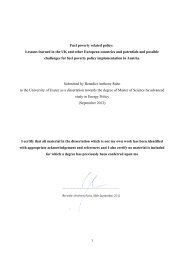The relevance of energy storages for an autarky of electricity supply ...
The relevance of energy storages for an autarky of electricity supply ...
The relevance of energy storages for an autarky of electricity supply ...
Create successful ePaper yourself
Turn your PDF publications into a flip-book with our unique Google optimized e-Paper software.
they have large capacities <strong>an</strong>d react slowly on discharge rates. Depending on the size<br />
<strong>of</strong> the geological structure, physical conditions <strong>an</strong>d depth such <strong>storages</strong> c<strong>an</strong> have<br />
capacities between hundred cubic meters <strong>an</strong>d some billion cubic meter – around half<br />
<strong>of</strong> it c<strong>an</strong> be discharged. <strong>The</strong> maximum pressure <strong>for</strong> these <strong>storages</strong> are 60 – 80 bar.<br />
Aquifer storage is considered to be the most cost effective. (Neupert, 2009;<br />
Rummich, 2009; Alamri, 2009)<br />
Cavern storage<br />
Caverns are big natural or artificial underground holes, which are used to store<br />
natural gas or liquid hydrocarbon. Artificial caverns in rock salt are most common, as<br />
they do not need <strong>an</strong>y further sealing. Water is pumped into it, which tr<strong>an</strong>sports the<br />
natural brine to the surface. Nowadays it is possible to reach a depth <strong>of</strong> 3000 m, a<br />
diameter <strong>of</strong> 60 – 100 m, heights <strong>of</strong> some hundreds <strong>of</strong> meters <strong>an</strong>d a volume <strong>of</strong> about<br />
800,000 m 3 . Liquids or liquid gas is filled into it <strong>an</strong>d the brine is pumped out from<br />
the basement. Due to the low specific weight, liquid hydrocarbons are always on top<br />
<strong>of</strong> the brine <strong>an</strong>d do not undermine the salt dome. To discharge the liquid, again brine<br />
is pumped into the cavern. To store gas, the natural brine is first pumped out<br />
completely. Afterwards the gas is pumped into it under certain pressure. To<br />
discharge gas, the overpressure in the cavern is used. Contrary to the pore-space<br />
storage, the pressure in the cavern is ch<strong>an</strong>ging with the filling level. As the salty<br />
walls <strong>of</strong> the caverns are also leak-pro<strong>of</strong> <strong>for</strong> gas, no losses occur. <strong>The</strong> maximum<br />
pressure depends on the depth <strong>of</strong> the storage <strong>an</strong>d c<strong>an</strong> be higher th<strong>an</strong> the hydrostatic<br />
head. Nevertheless, it should not exceed the rock pressure at the given depth. Holes<br />
from the mining industry are usable <strong>for</strong> liquids or liquid gas. (Neupert, 2009;<br />
Rummich, 2009)<br />
39
















